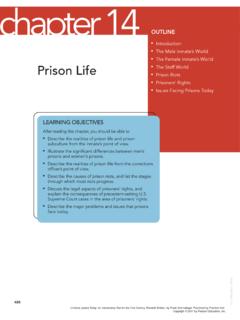Transcription of Content of the Patient Record: Inpatient, Outpatient, and ...
1 Chapter 6 Content of the PatientRecord: Inpatient, Outpatient, andPhysician OfficeChapter OutlineKey Termsaddressograph machineadmission noteadmission/discharge recordadmitting diagnosisadvance directiveadvance directive notification formagainst medical advice (AMA)aliasambulance reportambulatory recordancillary reportsancillary service visitanesthesia recordantepartum recordanti-dumping legislationAPGAR scoreattestation statementautomatic stop orderautopsyautopsy reportbedside terminal systembirth certificatebirth historycase management notecertificate of birthcertificate of deathchief complaint (CC)clinical dataclinical r sum comorbiditiescomplicationsconditions of admissionconsent to admission Key Terms Objectives Introduction General Documentation Issues Hospital Inpatient Record AdministrativeData Hospital Inpatient Record Clinical Data OPPS Major and Minor Procedures Hospital Outpatient Record Physician Office Record Forms Control and Design Internet Links summary Study checklist Chapter Review1199781133889731, Essentials of Health Information Management: Principles and Practices, Second Edition, Green/Bowie - Cengage rights reserved.
2 No distribution allowed without express reportdeath certificatedietary progress notedifferential diagnosisdischarge notedischarge orderdischarge summarydoctors ordersDRG creepdurable power of attorneyemergency recordencounterencounter formface sheetfacility identificationfamily historyfee slipfinal diagnosis first-listed diagnosisfollow-up progress noteforms committeegraphic sheethealth care proxyhistoryhistory of present illness (HPI)informed consentintegrated progress notesinterval historylabor and delivery recordlicensed practitionermacroscopicmaximizing codesmedication administration record (MAR)necropsynecropsy reportneonatal recordnewborn identificationnewborn physical examinationnewborn progress notesnon-licensed practitionernurses notesnursing care plannursing discharge summarynursing documentationobstetrical recordoccasion of serviceoperative recordoutpatient visitpast historypathology reportpatient identificationpatient record documentation committeepatient property formphysical examinationphysician office recordphysician orderspostanesthesia care unit (PACU) recordpostanesthesia evaluation notepostmortem reportpostoperative notepostpartum recordpreanesthesia evaluation noteprenatal recordpreoperative noteprincipal diagnosisprincipal procedureprogress notesread and verified (RAV)
3 Recovery room recordrehabilitation therapy progress noterespiratory therapy progress notereview of systems (ROS)routine ordersecondary diagnosessecondary proceduresshort stayshort stay recordsocial historystanding orderstop ordersuperbilltelephone order call back policytissue reporttransfer orderUniform Ambulatory care Data Set (UACDS)Uniform Hospital Discharge Data Set (UHDDS)upcodingverbal orderwritten order120 Chapter 6 ObjectivesAt the end of this chapter, the student shouldbe able to: Define key terms Explain general documentation issues that impact allpatient records Differentiate between administrative and clinical datacollected on patients List the contents of inpatient, outpatient, and physi-cian office records Detail forms design and control requirements,including the role of the forms committee9781133889731, Essentials of Health Information Management: Principles and Practices, Second Edition, Green/Bowie - Cengage rights reserved.
4 No distribution allowed without express care providers ( , hospitals, physician of-fices, and so on) are responsible for maintaining arecord for each Patient who receives health care serv-ices. If accredited, the provider must comply withstandards that impact Patient record keeping ( , TheJoint Commission). In addition, federal and statelaws and regulations ( , Medicare Conditions ofParticipation) provide guidance about Patient recordcontent requirements ( , inpatient, outpatient, andso on). To appropriately comply with accreditationstandards and federal and state laws and regulations,most facilities establish a forms design and controlprocedure along with a forms committee to managethe :For Content of alternate care Patient records( , home health care , hospice care , long-term care ,and so on), refer to Delmar Cengage Learning sComparative Records for Health Information Managementby Ann DOCUMENTATION ISSUESThe Joint Commission standards require that thepatient record contain Patient -specific informationappropriate to the care , treatment, and servicesprovided.
5 Patient records contain clinical/case infor-mation ( , documentation of emergency servicesprovided prior to inpatient admission), demographicinformation ( , Patient name, gender, etc.), andother information ( , advanced directive).Medicare Conditions of Participation (CoP) requireeach hospital to establish a medical record servicethat has administrative responsibility for medicalrecords, and the hospital must maintain a medicalrecord for each inpatient and outpatient. Medicalrecords must be accurately written, promptlycompleted, properly filed, properly retained, andaccessible. The hospital must use a system of authoridentification and record maintenance that ensuresthe integrity of the authentication and protects thesecurity of all record entries.
6 The medical recordmust contain information to justify admission andcontinued hospitalization, support the diagnosis, anddescribe the Patient s progress and response to med-ications and services. All entries must be legible andcomplete, and must be authenticated and datedpromptly by the person (identified by name and dis-cipline) who is responsible for ordering, providing,or evaluating the service furnished. The author ofeach entry must be identified and must authenticatehis or her entry authentication may includesignatures, written initials or computer records must be retained in their original orlegally reproduced form for a period of at least 5years, and the hospital must have a system of codingand indexing medical records to allow for timely re-trieval by diagnosis and procedure to support med-ical care evaluation studies.
7 The hospital must have aprocedure for ensuring the confidentiality of patientrecords. Information from or copies of records maybe released only to authorized individuals, and thehospital must ensure that unauthorized individualscannot gain access to or alter Patient medical records must be released by thehospital only in accordance with federal or statelaws, court orders, or Patient record is a valuable tool that documentscare and treatment of the Patient . It is essential thatevery report in the Patient record contain patientidentification,which consists of the Patient s nameand some other piece of identifying information suchas medical record number or date of birth. Everyreport in the Patient record and every screen in an elec-tronic health record (EHR) must include the Patient sname and medical record number.
8 In addition, for paper-based reports that are printed on both sides of apiece of paper, Patient identification must be includedon both sides. Paper-based documents that containmultiple pages ( , computer-generated lab reports)must include Patient identification information on :Some patients insist on the use of an alias,which is an assumed name, during their Patient might be a movie star or sports figure;receiving health care services under an alias affordsprivacy ( , protection from the press). The namethat the Patient provides is accepted as the officialname, and the true name can be entered in the masterpatient index as an AKA (also known as). However,the true name is not entered in the Patient record or inthe billing files.
9 Patients who choose to use an aliasshould be informed that their insurance companyprobably will not reimburse the facility for care pro-vided, and the Patient will be responsible for pay-ment. In addition, use of an alias can adversely impactcontinuity of pregnant Patient was admitted to the hospital andsigned in under an alias. Her baby was delivered, and thebaby s last name was entered on the record using thealias. The Patient explained that an order of protectionContent of the Patient Record: Inpatient, Outpatient, and Physician Office 1219781133889731, Essentials of Health Information Management: Principles and Practices, Second Edition, Green/Bowie - Cengage rights reserved.
10 No distribution allowed without express been issued because her spouse was abusive and shedidn t want him to know that she had been admitted todeliver the baby. Upon discharge, she and the baby trav-eled to a safe is common for health care facilities to print the attending/primary care physician s name and the date of admission/visit on each form using an addressograph machine(Figure 6-1), which imprintspatient identification information on each report. Aplastic card that looks similar to a credit card is createdfor each Patient and placed in the addressograph ma-chine to make an impression on the report. Using anaddressograph also allows forms to be imprinted priorto Patient admission, creating the record ahead oftime.




